|
Airplanes
by Lumir G. Janku
1996
from
AnomaliesAndEnigmasLibrary Website
This object (shown in sketch) was found
in 1898 in a tomb at Saqquara, Egypt and was later
dated as having been created near 200 BCE. As airplanes were unknown
in the days when it was found, it was thrown into a box marked
"wooden bird model" and then stored in the basement of the Cairo
museum.
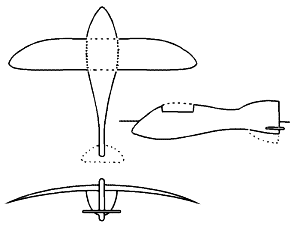 It
was rediscovered by Dr. Khalil Messiha, who studied models
made by ancients. The "discovery" was considered so important by the
Egyptian government that a special committee of leading scientists
was established to study the object. As a result of their findings,
a special exhibit was set up in the center hall of the Cairo museum,
with the little model as its centerpiece. It was even labeled as a
model airplane. It
was rediscovered by Dr. Khalil Messiha, who studied models
made by ancients. The "discovery" was considered so important by the
Egyptian government that a special committee of leading scientists
was established to study the object. As a result of their findings,
a special exhibit was set up in the center hall of the Cairo museum,
with the little model as its centerpiece. It was even labeled as a
model airplane.
To elucidate the reasons for the decision of the committee, almost
unprecedented in the field of archeology, let's consider some
aspects of the model. The model has the exact proportions of a very
advanced form of "pusher-glider" that is still having "some bugs
ironed out". This type of glider will stay in the air almost by
itself—even a very small engine will keep it going at low
speeds, as low as 45 to 65 mph., while it can carry an enormous
payload.
This ability is dependent on the curious shape of wings
and their proportions. The tipping of wings downward, a reversedihedral wing as it is called, is the feature behind this
capability. A similar type of curving wings are implemented on the
Concorde airplane, giving the plane a maximum lift without
detracting from its speed.
In that context, it seems rather incredible that someone, more than
2,000 years ago, for any reason, devised a model of a flying device
with such advanced features, requiring quite extensive knowledge of
aerodynamics. There were no such things as airplanes in these times,
we are told by archeologists and historians. But this case seems to
be an exception, living in the midst of the rather unimaginative and
rigid paradigm of contemporary science. It is also necessary to
point out that Egyptians are known to have nearly always made
scale-models of projects and objects which they planned to create or
build.
Is the concept of an airplane limited to Egypt? That doesn't
seem to be the case. Gold trinkets were found in an area
covering Central America and coastal areas of South
America, estimated to belong to a period between 500 and 800 CE,
but since they are made from gold, accurate dating is
impossible and based essentially on stratigraphy which may be
deceptive. However, we can safely say that these gold objects are
more than 1000 years old.
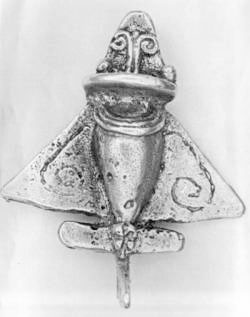 As
seen from the pictures, the shape of the sample object is rather
ambiguous. The archeologists labeled these objects as zoomorphic,
meaning, animal shaped objects. The question is, what animal
do they represent? When we compare these with other objects from the
same cultures depicting animals, a curious facet of the comparison
would be obvious: the other objects are recognizable, rendered
usually with a great accuracy and attention to realistic detail. As
seen from the pictures, the shape of the sample object is rather
ambiguous. The archeologists labeled these objects as zoomorphic,
meaning, animal shaped objects. The question is, what animal
do they represent? When we compare these with other objects from the
same cultures depicting animals, a curious facet of the comparison
would be obvious: the other objects are recognizable, rendered
usually with a great accuracy and attention to realistic detail.
There are several types of animals which fly—birds, insects, and
several mammals, such as bats and some gliders, for instance flying
squirrels, oppossums, and then there are some lizards; there are
also some fish which for brief periods glide through the air. There
are water animals which seem to fly through the water, such as rays,
skates and some selachians. But how does the depicted object compare
with these choices? All its features taken into a consideration, we
have no match. Seen from above, the object obviously has no fish
features, but seems to show rather explicitly mechanistic ones.
The structures just in front of the tail are strongly reminiscent of
elevons (a combination of ailerons and elevators)
with a slight forward curve, but they are attached to the fuselage,
rather than the wings. In any case, they look more like airplane
parts than like the claspers of a fish. If the two prominent spirals
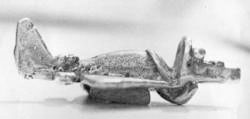 on
the wings are supposed to be a stylized version of the eyes of a
ray, then what are the two globular objects positioned on the head
supposed to represent? on
the wings are supposed to be a stylized version of the eyes of a
ray, then what are the two globular objects positioned on the head
supposed to represent?
To complicate the identification even more,
the spirals on the wings have their copies positioned on the nose of
the object, in the opposite direction. When the object is viewed in
profile, the dissimilarity to anything from the animal kingdom is
even more pronounced. If the zoomorphic explanation is
supposed to hold, then why did the artist cut the head off almost
three quarters from the body?
And why is the nose is practically
rectangular and the cut tilted forward, with eyes positioned at
either side, when fish eyes are usually more near the center of
bodyline and far forward on the head?
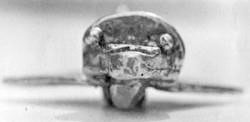 What
we can make of the semicircular grooves on the inside of the cut?
What is it supposed to be—fishwise? And what about the scoop,
forward and under the cut? It is a scoop, not just a ridge for
drilling a hole through to place the object on a necklace chain. What
we can make of the semicircular grooves on the inside of the cut?
What is it supposed to be—fishwise? And what about the scoop,
forward and under the cut? It is a scoop, not just a ridge for
drilling a hole through to place the object on a necklace chain.
Then there is another rectangular feature, positioned further back
at the approximate center of gravity under the fuselage. The wings
when viewed from the side are perfectly horizontal, but when seen
from the front, they curve slightly downward. The elevators, which
are right behind the wings, are positioned on a slightly higher
horizontal level and are square-ended, thus a definite geometric
shape.
Above them is another rectangular shape, with a relief which
may be reminiscent of knobs. The tail is equally intriguing.
No fish has only a single, upright and perpendicular flange. But
this tail fin has an exact shape of fins on modern airplanes. There
are also some markings on the tail which are hard to identify, but
it does not seem to be anything related to animals, either.
When all the features are taken into an account, the object does not
look like a representation of any known animal at all, but does look
astonishingly like an airplane. The photos and enlarged
outline of the object has been submitted for an analysis to several
people from the field of aerodynamics.
One of them was Arthur
Young, a designer of Bell helicopters and other aircraft.
His analysis confirmed that the object contains many features which
would fit the airplane hypothesis, but there were several ones which
would not fit that scenario. Wings do seem to be in the wrong
place—they should be further forward so that their 1/4-chord
coincides with the center of gravity. The nose is not like anything
on airplanes, as well. So, while the object is suggesting an
airplane, some features would not seem to support this
hypothesis.
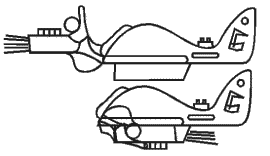 But
let's entertain several possibilities. If we imagine that the
separation after the windshield is not a cockpit and that the pilot
and the cargo were located somewhere in the main fuselage body, then
we can envision the nose as something else. Let's assume that the
nose is actually a jet. If the machine needs to slow down, the jet
flow directed against the path of flight would accomplish just that. But
let's entertain several possibilities. If we imagine that the
separation after the windshield is not a cockpit and that the pilot
and the cargo were located somewhere in the main fuselage body, then
we can envision the nose as something else. Let's assume that the
nose is actually a jet. If the machine needs to slow down, the jet
flow directed against the path of flight would accomplish just that.
But how to redirect the jet into the opposite direction? If we
envision the nose as a movable part of the plane, turning around the
point located where the nose and fuselage meet, thus pivoting the
nose downward to tuck it under the fuselage, that would enable the
desired effect. What's more, it will re-adjust the center of gravity
and the wings would be just in the right place for a high powered
flight.
Another problem, though, will appear and that is the drag
which would be created by the back of the nose now positioned in
front. But that can be attributed to artistic license. That seems to
be the case, because several other similar planes feature the back
part of the nose tilted more forward, so the angle of the back of
the nose when pivoted is more corresponding to aerodynamic
principles.
All things considered, the object seems to represent a
convertible type of craft, with two possible configurations—one
for ascent when the nose is facing backwards, and the other for
descent with the nose facing forward. One unsolved item remains—the
spirals on the both wings and the nose. According to Amerindian
iconography, these spirals have discernable meaning—they
represent ascending and descending, depending on whether they
are right-oriented or left-oriented, respectively. As the spirals
are not only on wings but also on the nose, the meaning is fairly
obvious—the wings and the nose (as much) were the
features which were directly involved in ascent and descent.
There are other cultures which mention flying vehicles of some sort
or another. The most known of these sources are Indian epics,
especially the
Mahábhárata and other Védic sources
as Bhágavata Purána and
Rámáyana. The flying devices were
called
vimánas and were extensively discussed in
Vaimánika
Shástra, describing multitude of machines with different
purposes and capabilities.
Other source of information about flying machines may be considered,
such as the Bible and some apocryphal works. The
book of Ezekiel seems to be
describing the close encounter of a man from a non-technological
culture with a device which to him must have been miraculous. We
have to put ourselves into his shoes to comprehend his astonishment
and the other worldness of his encounter.
The limited scope of
knowledge of the world around him, his primitive environment,
dictated the language and conceptual framework with which he tried
to capture his encounter for fellow tribesmen. For him it seemed
that he encountered The God, with his suite of angels,
because in his simple world, there was no other interpretation. It
is not necessary to reach for an alien type of scenario to
explain the encounter; we can entertain a possibility that a remnant
of an advanced civilization was still present, in a limited
scope, at the time of Ezekiel.
But for some, the encounter
bears uncanny similarity to the modern-day encounters with UFO's.
Another source of similar material is the
Book of Enoch, particularly the Slavic version,
which contains some parts which the Greek version is missing.
The
book not only describes flying in the air, but also through outer
space, including the relativistic effects mentioned—Enoch spent several days on a spacecraft, but when he returned to
Earth, several centuries had passed by.
There is no shortage of descriptions of flying machines in
ancient sources. If we try to extract the core of myths of
different provenience and remove the embellishments, we discover to
our surprise that flying in ancient times seems to be the rule,
not the exception.
|
 It
was rediscovered by Dr. Khalil Messiha, who studied models
made by ancients. The "discovery" was considered so important by the
Egyptian government that a special committee of leading scientists
was established to study the object. As a result of their findings,
a special exhibit was set up in the center hall of the Cairo museum,
with the little model as its centerpiece. It was even labeled as a
model airplane.
It
was rediscovered by Dr. Khalil Messiha, who studied models
made by ancients. The "discovery" was considered so important by the
Egyptian government that a special committee of leading scientists
was established to study the object. As a result of their findings,
a special exhibit was set up in the center hall of the Cairo museum,
with the little model as its centerpiece. It was even labeled as a
model airplane. As
seen from the pictures, the shape of the sample object is rather
ambiguous. The archeologists labeled these objects as zoomorphic,
meaning, animal shaped objects. The question is, what animal
do they represent? When we compare these with other objects from the
same cultures depicting animals, a curious facet of the comparison
would be obvious: the other objects are recognizable, rendered
usually with a great accuracy and attention to realistic detail.
As
seen from the pictures, the shape of the sample object is rather
ambiguous. The archeologists labeled these objects as zoomorphic,
meaning, animal shaped objects. The question is, what animal
do they represent? When we compare these with other objects from the
same cultures depicting animals, a curious facet of the comparison
would be obvious: the other objects are recognizable, rendered
usually with a great accuracy and attention to realistic detail. on
the wings are supposed to be a stylized version of the eyes of a
ray, then what are the two globular objects positioned on the head
supposed to represent?
on
the wings are supposed to be a stylized version of the eyes of a
ray, then what are the two globular objects positioned on the head
supposed to represent?  What
we can make of the semicircular grooves on the inside of the cut?
What is it supposed to be—fishwise? And what about the scoop,
forward and under the cut? It is a scoop, not just a ridge for
drilling a hole through to place the object on a necklace chain.
What
we can make of the semicircular grooves on the inside of the cut?
What is it supposed to be—fishwise? And what about the scoop,
forward and under the cut? It is a scoop, not just a ridge for
drilling a hole through to place the object on a necklace chain.
 But
let's entertain several possibilities. If we imagine that the
separation after the windshield is not a cockpit and that the pilot
and the cargo were located somewhere in the main fuselage body, then
we can envision the nose as something else. Let's assume that the
nose is actually a jet. If the machine needs to slow down, the jet
flow directed against the path of flight would accomplish just that.
But
let's entertain several possibilities. If we imagine that the
separation after the windshield is not a cockpit and that the pilot
and the cargo were located somewhere in the main fuselage body, then
we can envision the nose as something else. Let's assume that the
nose is actually a jet. If the machine needs to slow down, the jet
flow directed against the path of flight would accomplish just that.